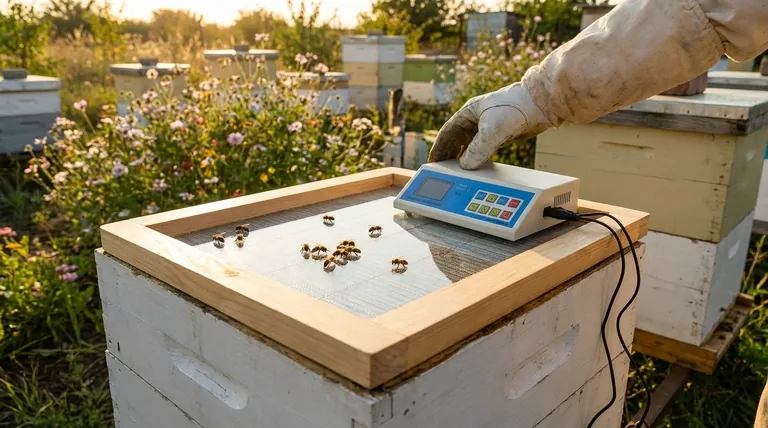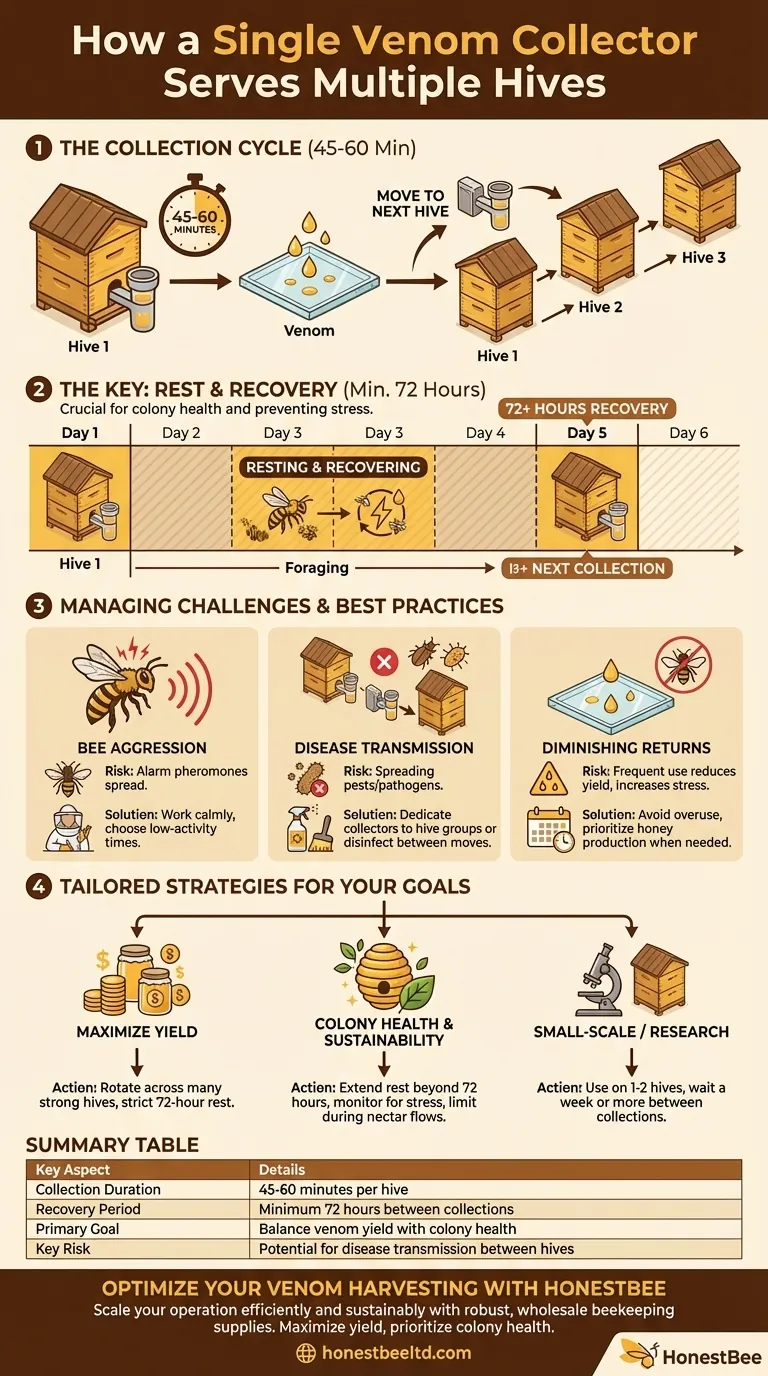In practice, a single venom collection apparatus is systematically rotated between several hives to maximize efficiency while managing bee colony health. The process involves placing the device at a hive entrance for a set period, typically 45 to 60 minutes, before turning it off and moving it to the next designated hive in a carefully planned sequence.
The ability to move a collector across multiple hives is the key to efficient venom harvesting. However, the core challenge is not the physical act of moving the device, but creating a rotation schedule that balances yield with the crucial need for colony recovery.

The Standard Operating Procedure for Multi-Hive Collection
Successfully using one apparatus on multiple hives depends on a disciplined and repeatable process. The goal is to stimulate venom release without causing undue long-term stress to the colonies.
The Collection Cycle
A typical collection cycle on a single hive is brief. The device is placed at the hive entrance and activated for a period of 45-60 minutes.
During this time, a mild electrical current encourages bees to sting a glass plate, depositing their venom without losing their stinger.
The Transfer Process
Once the time is up, the device is deactivated and carefully removed from the hive entrance. It is then immediately moved to the next hive in the rotation.
This process is repeated down a line of pre-selected, healthy hives within an apiary.
The "Rest and Recovery" Principle
This is the most critical element. A hive should not have venom collected from it every day. After a collection cycle, a hive requires a recovery period.
The standard recommendation is a minimum of 72 hours between collections for a single hive. This allows the colony to return to normal activity and ensures the bees can replenish any lost energy and morale. Constant stimulation leads to excessive stress and can harm the colony.
Understanding the Trade-offs and Best Practices
While efficient, rotating a collector introduces variables that must be managed to protect your bees and the quality of your venom.
Impact on Bee Aggression
The collection process releases alarm pheromones, which can make a colony more defensive. Moving a device from hive to hive can potentially spread this agitated state through the apiary.
Working calmly and efficiently helps minimize this. It's also wise to perform collections when fewer people are likely to be near the apiary.
Risk of Disease Transmission
A collection device that touches multiple hives can become a vector for transmitting pests and pathogens, such as Varroa mites or disease spores.
It is best practice to either dedicate specific collectors to specific groups of hives or to thoroughly clean and disinfect the apparatus frame before moving it between different apiaries or significantly separated hive groups.
Diminishing Returns
Attempting to collect from the same hives too frequently will lead to diminishing returns. The bees become less responsive to the stimulus, and the overall stress can reduce the colony's productivity in other areas, like honey production.
Making the Right Choice for Your Goal
Your collection strategy should be dictated by your primary objective. There is no single "best" method; there is only the best method for your specific goals.
- If your primary focus is maximizing yield: Implement a rotation across a large number of strong hives, adhering strictly to the 72-hour rest period for each colony to maintain productivity.
- If your primary focus is colony health and sustainability: Extend the rest period beyond 72 hours, collect less frequently during key nectar flows, and regularly monitor colonies for signs of stress.
- If your primary focus is small-scale or research collection: You may choose to use the apparatus on only one or two hives, with a week or more between collections to ensure minimal impact.
Ultimately, successful venom collection is an exercise in responsible stewardship of your colonies.
Summary Table:
| Key Aspect | Details |
|---|---|
| Collection Duration | 45-60 minutes per hive |
| Recovery Period | Minimum 72 hours between collections |
| Primary Goal | Balance venom yield with colony health |
| Key Risk | Potential for disease transmission between hives |
Optimize Your Venom Harvesting Operation with HONESTBEE
Are you a commercial apiary or beekeeping equipment distributor looking to scale your venom collection efficiently and sustainably? HONESTBEE supplies the robust, wholesale-focused beekeeping supplies and equipment you need to implement a successful multi-hive rotation strategy.
We provide durable venom collection apparatuses and expert guidance to help you maximize yield while prioritizing the long-term health of your colonies. Let us equip you for success.
Contact HONESTBEE today to discuss your wholesale equipment needs and build a more productive, sustainable operation.
Visual Guide

Related Products
- Full Set Beekeeping Electronic Bee Venom Collector Machine Device for Bee Venom Collecting
- Nicot Queen Rearing Kit for Beekeeping and Grafting in Nicot System
- HONESTBEE 6 Frame Three Use Electric Honey Extractor for Beekeeping
- Jenter Queen Rearing Kit Complete Set for Bee Breeding
- No Grafting Queen Rearing Kit: System for Royal Jelly Production and Queen Rearing
People Also Ask
- How many hives are needed on average to collect 1 gram of bee venom? A Guide to Low-Yield Harvesting
- How is bee venom typically collected using the electro-shock method? A Guide to Efficient, Non-Lethal Harvesting
- How long is each colony of bees 'milked' for venom collection? The 5-Minute Rule for Sustainable Harvesting
- How frequently should pollen be harvested from the traps? Ensure Optimal Hive Health & Superior Quality
- How much venom can be collected from a single bee? A Microscopic Yield of Immense Value



















